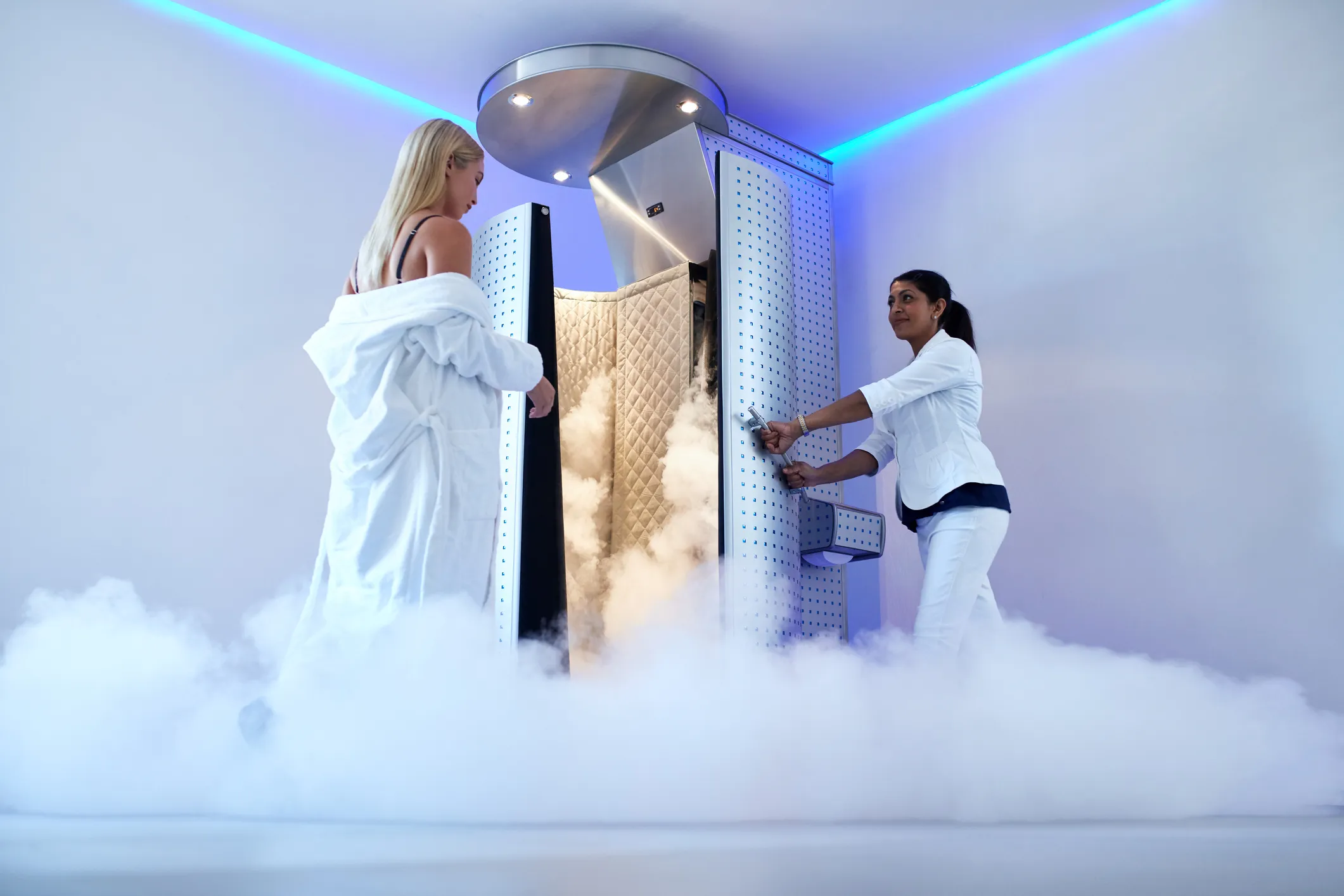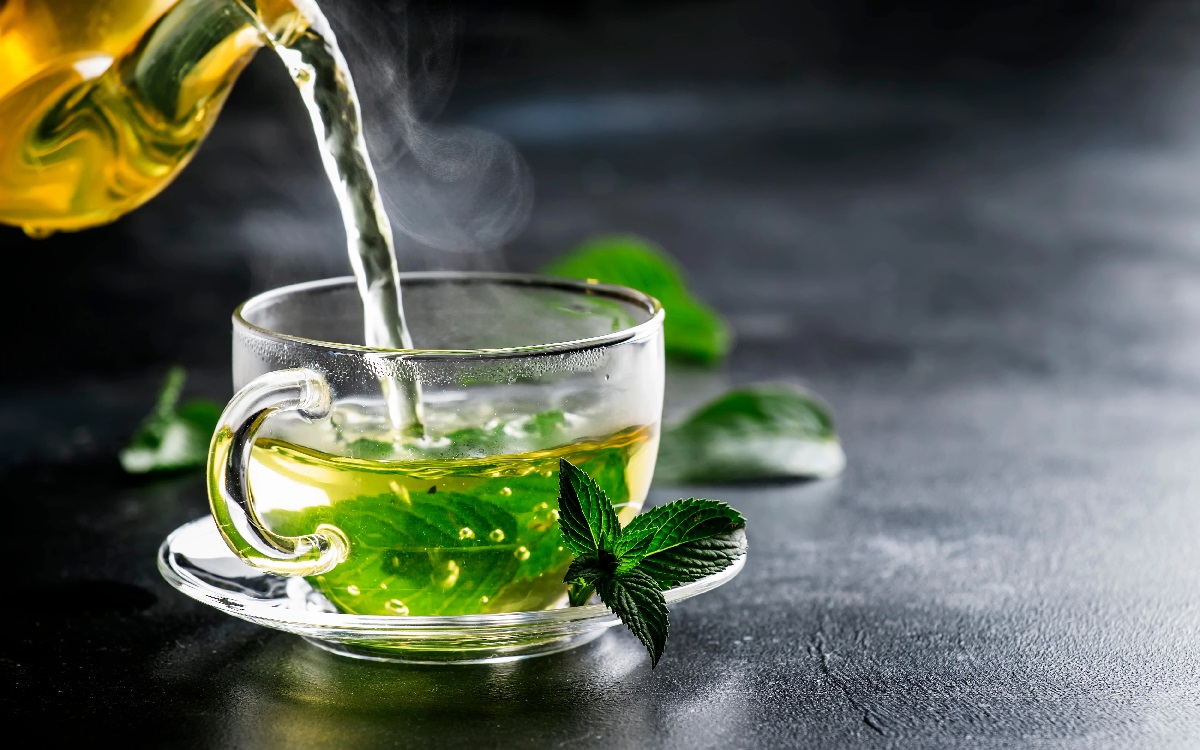Home>Health & Nutrition>Understanding Cryotherapy: Benefits And Mechanisms Explained


Health & Nutrition
Understanding Cryotherapy: Benefits And Mechanisms Explained
Published: February 19, 2024
Discover the benefits and mechanisms of cryotherapy for health and nutrition. Learn how this treatment can improve your overall well-being.
(Many of the links in this article redirect to a specific reviewed product. Your purchase of these products through affiliate links helps to generate commission for Temperatures.com, at no extra cost. Learn more)
Table of Contents
Introduction
Cryotherapy, derived from the Greek words "cryo" meaning cold and "therapy" meaning cure, is a therapeutic technique that involves exposing the body to extremely cold temperatures for various health benefits. This practice has gained popularity in recent years, with proponents touting its ability to alleviate muscle pain, improve recovery, and even enhance overall well-being. While cryotherapy has been utilized for decades in medical settings to treat certain conditions, it has now expanded into the realm of wellness and sports recovery, captivating the interest of athletes, fitness enthusiasts, and individuals seeking alternative health solutions.
The concept of subjecting the body to extreme cold may seem daunting at first, but the potential rewards have intrigued many. From whole-body cryotherapy sessions to localized treatments, the application of cold temperatures has been purported to stimulate physiological responses that can positively impact the body. As we delve deeper into the science behind cryotherapy and explore its diverse benefits, it becomes evident that this innovative approach to wellness holds promise for individuals seeking natural and non-invasive methods to support their health and vitality.
In the following sections, we will unravel the mechanisms that underpin cryotherapy, shedding light on the physiological responses that occur when the body is exposed to cold temperatures. Additionally, we will delve into the myriad benefits associated with cryotherapy, ranging from pain relief and muscle recovery to potential enhancements in skin health and overall well-being. Furthermore, we will explore the different methods through which cryotherapy can be administered, providing insights into the various approaches available to individuals seeking to incorporate this practice into their wellness routines.
As we embark on this exploration of cryotherapy, it is essential to approach this topic with an open mind, recognizing the potential it holds for optimizing health and well-being. By gaining a comprehensive understanding of cryotherapy and its applications, individuals can make informed decisions regarding its integration into their health and wellness regimens, paving the way for a deeper appreciation of this innovative therapeutic approach.
The Science Behind Cryotherapy
Cryotherapy operates on the principle of utilizing cold temperatures to induce physiological responses within the body. When the body is exposed to extreme cold, whether through whole-body cryotherapy chambers or localized applications, a cascade of intricate biological reactions is set into motion.
At the core of cryotherapy's mechanisms lies vasoconstriction, a process in which blood vessels constrict in response to cold exposure. This constriction serves as the body's innate defense mechanism to conserve heat and maintain core body temperature. As a result, the blood flow to the extremities is reduced, redirecting it to vital organs and tissues. This temporary reduction in blood flow to the periphery can lead to a decrease in inflammation and swelling, contributing to the alleviation of pain and discomfort in targeted areas.
Furthermore, the exposure to cold triggers the release of endorphins, the body's natural painkillers, which can help mitigate discomfort and enhance feelings of well-being. Additionally, the sudden drop in skin temperature prompts the activation of thermoreceptors, specialized nerve endings that transmit signals to the brain, initiating a series of responses aimed at preserving body heat and maintaining homeostasis.
Moreover, cryotherapy has been shown to stimulate the release of norepinephrine, a hormone and neurotransmitter that plays a role in regulating attention, focus, and mood. This release of norepinephrine can contribute to heightened alertness and a sense of invigoration following a cryotherapy session.
On a cellular level, the exposure to cold temperatures can activate brown adipose tissue, commonly referred to as brown fat, which possesses the unique ability to generate heat. This activation of brown fat can lead to an increase in energy expenditure, potentially contributing to weight management and metabolic regulation.
In addition to these physiological responses, cryotherapy has been suggested to modulate the inflammatory response, potentially influencing the body's immune function and recovery processes. The cold exposure may also promote the production of collagen and elastin, essential proteins for skin health, thereby potentially enhancing skin tone and texture.
By comprehending the intricate interplay of these physiological responses, individuals can gain a deeper appreciation for the scientific underpinnings of cryotherapy and its potential to positively impact various facets of health and well-being. This understanding serves as a foundation for exploring the diverse benefits that cryotherapy offers, shedding light on its capacity to support recovery, alleviate discomfort, and promote overall vitality.
Benefits of Cryotherapy
Cryotherapy offers a myriad of potential benefits that span across physical, mental, and even aesthetic dimensions. From alleviating muscle soreness to potentially enhancing skin health, the application of cold temperatures has garnered attention for its diverse therapeutic effects.
1. Pain Relief and Muscle Recovery
One of the most widely recognized benefits of cryotherapy is its potential to alleviate pain and expedite muscle recovery. By inducing vasoconstriction and reducing inflammation, cryotherapy may offer relief from muscle soreness, aches, and discomfort following intense physical activity or injury. Athletes and fitness enthusiasts often turn to cryotherapy to support their recovery process and enhance their overall performance.
2. Enhanced Well-Being and Mood
The release of endorphins, often referred to as the body's natural feel-good hormones, during cryotherapy sessions can contribute to an improved sense of well-being and mood. Many individuals report feeling invigorated and uplifted following a cryotherapy session, attributing this to the release of endorphins and the overall sense of rejuvenation that accompanies the experience.
3. Potential Metabolic and Weight Management Effects
The activation of brown adipose tissue, known for its role in heat production, can lead to an increase in energy expenditure. This effect has sparked interest in the potential of cryotherapy to support metabolic regulation and weight management. While further research is needed to fully elucidate the extent of these effects, the metabolic implications of cryotherapy present an intriguing area for exploration.
4. Skin Health and Rejuvenation
Cryotherapy has been associated with potential benefits for skin health and rejuvenation. The cold exposure may stimulate the production of collagen and elastin, essential proteins that contribute to skin elasticity and tone. This has led to the incorporation of cryotherapy in certain skincare regimens, with proponents suggesting that it may contribute to improved skin texture and overall appearance.
5. Exercise Performance and Recovery
In the realm of sports and fitness, cryotherapy has garnered attention for its potential to enhance exercise performance and expedite recovery. By mitigating post-exercise inflammation and supporting muscle recovery, cryotherapy may offer athletes and fitness enthusiasts a natural and non-invasive means of optimizing their training regimens.
6. Potential Immune Modulation
Some research suggests that cryotherapy may modulate the body's inflammatory response and potentially influence immune function. While further studies are warranted to fully elucidate the extent of these effects, the potential immune-modulating properties of cryotherapy present an intriguing area for exploration in the context of overall health and wellness.
By embracing the potential benefits of cryotherapy, individuals can explore this innovative approach to wellness with a keen awareness of its diverse effects. From supporting physical recovery and exercise performance to potentially enhancing skin health and overall well-being, cryotherapy offers a multifaceted avenue for individuals seeking natural and non-invasive methods to optimize their health and vitality.
Read more: Enzymes: Reusability And Benefits
Different Methods of Cryotherapy
Cryotherapy encompasses a spectrum of methods that leverage cold temperatures to elicit therapeutic effects, catering to diverse preferences and targeted applications. Understanding the various modalities of cryotherapy allows individuals to explore options that align with their specific wellness goals and preferences.
Whole-Body Cryotherapy (WBC)
Whole-body cryotherapy involves exposing the entire body to extreme cold temperatures, typically in a specialized chamber or cabin. During a WBC session, individuals are immersed in temperatures ranging from -100°C to -140°C for a brief duration, usually lasting two to four minutes. This method is favored for its potential to induce systemic physiological responses, including vasoconstriction, the release of endorphins, and the activation of brown adipose tissue. WBC has gained popularity among athletes and individuals seeking overall wellness, with proponents attributing benefits such as enhanced recovery, improved mood, and potential metabolic effects to this approach.
Localized Cryotherapy
In contrast to whole-body cryotherapy, localized cryotherapy targets specific areas of the body, delivering cold therapy to localized regions. This can be achieved through various means, including ice packs, cooling sprays, or specialized devices that administer targeted cold therapy. Localized cryotherapy is often utilized to address acute injuries, localized pain, or inflammation in specific areas, offering a focused approach to alleviating discomfort and promoting recovery.
Cryotherapy Chambers and Tubs
Cryotherapy chambers and tubs provide a controlled environment for individuals to experience cold therapy. These chambers are equipped with mechanisms to regulate temperature and duration, ensuring a safe and standardized experience. The use of cryotherapy chambers and tubs allows for consistent and controlled exposure to cold temperatures, catering to individuals seeking a comprehensive whole-body experience.
Cryofacial and Localized Cryotherapy Devices
Cryofacial treatments and localized cryotherapy devices are designed to target the face and specific areas of the body, offering localized cold therapy for aesthetic and therapeutic purposes. Cryofacial treatments involve the application of cold temperatures to the face, potentially contributing to skin rejuvenation and toning. Localized cryotherapy devices, on the other hand, provide targeted cold therapy to specific body parts, offering a versatile approach to addressing localized discomfort and promoting skin health.
Cryotherapy Wraps and Patches
Cryotherapy wraps and patches offer a convenient and targeted means of applying cold therapy to specific areas of the body. These products are designed to adhere to the skin, delivering sustained cold therapy to the targeted area. Cryotherapy wraps and patches are favored for their portability and ease of use, providing individuals with a flexible option for incorporating localized cold therapy into their wellness routines.
By exploring the diverse methods of cryotherapy, individuals can tailor their approach to cold therapy based on their unique needs and preferences. Whether seeking whole-body rejuvenation, targeted pain relief, or skin health benefits, the array of cryotherapy modalities offers a versatile and customizable landscape for individuals to embark on their journey toward enhanced well-being and vitality.
Risks and Considerations
While cryotherapy offers a range of potential benefits, it is essential to consider the associated risks and precautions to ensure a safe and informed approach to cold therapy. Understanding the potential drawbacks and considerations surrounding cryotherapy empowers individuals to make well-informed decisions regarding its incorporation into their wellness regimens.
Potential Adverse Reactions
Exposure to extreme cold temperatures, particularly in whole-body cryotherapy sessions, carries the risk of adverse reactions in certain individuals. These may include skin irritation, redness, or even frostbite if proper protective measures are not observed. It is crucial to adhere to recommended session durations and ensure that the skin is adequately protected during cryotherapy to mitigate the risk of adverse skin reactions.
Contraindications and Precautions
Individuals with certain medical conditions, such as uncontrolled hypertension, heart conditions, or circulatory disorders, may be at an increased risk of adverse effects from cryotherapy. Additionally, pregnant women and individuals with sensory disorders should exercise caution and consult with healthcare professionals before undergoing cryotherapy. Understanding the contraindications and precautions associated with cryotherapy is paramount in ensuring the safety and well-being of individuals considering this therapeutic approach.
Regulatory Considerations
As cryotherapy gains popularity, it is important to be mindful of the regulatory landscape surrounding its practice. Ensuring that cryotherapy facilities adhere to established safety standards and protocols is crucial for minimizing potential risks. Individuals seeking cryotherapy should verify the credentials and compliance of the facilities offering these services to uphold safety and quality standards.
Individual Tolerance and Sensitivity
The response to cold temperatures can vary among individuals, and factors such as tolerance to cold, skin sensitivity, and overall health should be taken into account. It is advisable for individuals to start with shorter exposure durations and gradually increase as tolerated, allowing the body to acclimate to the cold stimulus. Monitoring individual tolerance and sensitivity to cryotherapy can help mitigate the risk of adverse reactions and optimize the overall experience.
Professional Guidance and Informed Consent
Seeking professional guidance from healthcare providers or qualified cryotherapy practitioners is essential, especially for individuals with underlying health conditions or concerns. Engaging in open and transparent discussions with healthcare professionals can provide valuable insights and personalized recommendations, ensuring that cryotherapy is approached in a manner that aligns with individual health needs and goals. Additionally, obtaining informed consent and thoroughly understanding the potential risks and benefits of cryotherapy is fundamental in fostering a safe and responsible approach to this therapeutic modality.
By acknowledging the risks and considerations associated with cryotherapy, individuals can approach this innovative wellness practice with a heightened sense of awareness and responsibility. Embracing a well-informed and cautious approach to cryotherapy allows individuals to harness its potential benefits while prioritizing safety and well-being.
Conclusion
In conclusion, the realm of cryotherapy presents a compelling landscape of potential benefits and innovative approaches to supporting health and well-being. From the intricate physiological responses elicited by exposure to cold temperatures to the diverse array of benefits spanning physical recovery, mood enhancement, and potential skin health effects, cryotherapy offers a multifaceted avenue for individuals seeking natural and non-invasive methods to optimize their vitality.
The scientific underpinnings of cryotherapy, rooted in vasoconstriction, endorphin release, and the activation of brown adipose tissue, provide a deeper understanding of the mechanisms that drive its therapeutic effects. This comprehension serves as a foundation for exploring the diverse benefits that cryotherapy offers, shedding light on its capacity to support recovery, alleviate discomfort, and promote overall vitality.
Moreover, the availability of various cryotherapy modalities, including whole-body cryotherapy, localized treatments, and specialized devices, empowers individuals to tailor their approach to cold therapy based on their unique needs and preferences. Whether seeking whole-body rejuvenation, targeted pain relief, or skin health benefits, the array of cryotherapy methods offers a versatile and customizable landscape for individuals to embark on their journey toward enhanced well-being and vitality.
However, it is crucial to approach cryotherapy with a keen awareness of the associated risks and considerations. Adhering to recommended safety measures, understanding contraindications, and seeking professional guidance are essential steps in ensuring a safe and responsible approach to this therapeutic modality. By acknowledging the potential drawbacks and exercising caution, individuals can harness the benefits of cryotherapy while prioritizing their safety and well-being.
As cryotherapy continues to captivate interest and evolve within the realms of wellness, sports recovery, and holistic health, it is imperative for individuals to approach this practice with a balanced perspective, informed by both its potential benefits and associated considerations. By embracing a well-informed and cautious approach to cryotherapy, individuals can unlock the potential of this innovative therapeutic modality while safeguarding their health and vitality.
In essence, cryotherapy stands as a testament to the ongoing exploration of natural and holistic approaches to health, inviting individuals to embark on a journey toward enhanced well-being through the transformative power of cold therapy.










